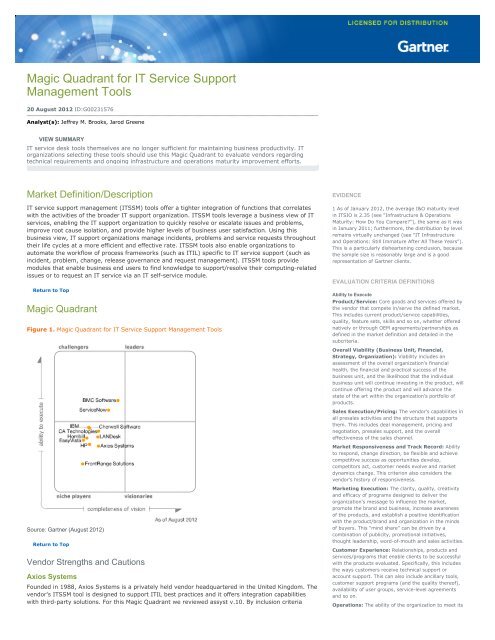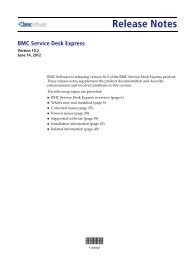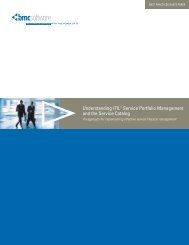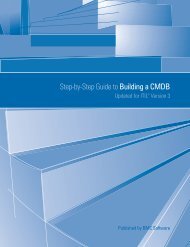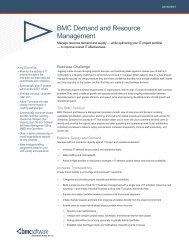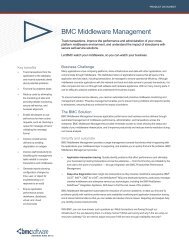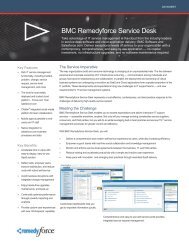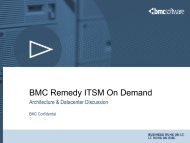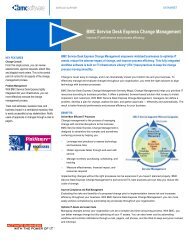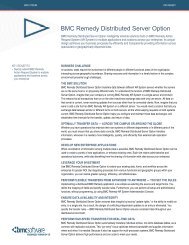Magic Quadrant for IT Service Support Management Tools - RightStar
Magic Quadrant for IT Service Support Management Tools - RightStar
Magic Quadrant for IT Service Support Management Tools - RightStar
- No tags were found...
You also want an ePaper? Increase the reach of your titles
YUMPU automatically turns print PDFs into web optimized ePapers that Google loves.
<strong>Magic</strong> <strong>Quadrant</strong> <strong>for</strong> <strong>IT</strong> <strong>Service</strong> <strong>Support</strong><strong>Management</strong> <strong>Tools</strong>20 August 2012 ID:G00231576Analyst(s): Jeffrey M. Brooks, Jarod GreeneVIEW SUMMARY<strong>IT</strong> service desk tools themselves are no longer sufficient <strong>for</strong> maintaining business productivity. <strong>IT</strong>organizations selecting these tools should use this <strong>Magic</strong> <strong>Quadrant</strong> to evaluate vendors regardingtechnical requirements and ongoing infrastructure and operations maturity improvement ef<strong>for</strong>ts.Market Definition/Description<strong>IT</strong> service support management (<strong>IT</strong>SSM) tools offer a tighter integration of functions that correlateswith the activities of the broader <strong>IT</strong> support organization. <strong>IT</strong>SSM tools leverage a business view of <strong>IT</strong>services, enabling the <strong>IT</strong> support organization to quickly resolve or escalate issues and problems,improve root cause isolation, and provide higher levels of business user satisfaction. Using thisbusiness view, <strong>IT</strong> support organizations manage incidents, problems and service requests throughouttheir life cycles at a more efficient and effective rate. <strong>IT</strong>SSM tools also enable organizations toautomate the workflow of process frameworks (such as <strong>IT</strong>IL) specific to <strong>IT</strong> service support (such asincident, problem, change, release governance and request management). <strong>IT</strong>SSM tools providemodules that enable business end users to find knowledge to support/resolve their computing-relatedissues or to request an <strong>IT</strong> service via an <strong>IT</strong> self-service module.Return to Top<strong>Magic</strong> <strong>Quadrant</strong>Figure 1. <strong>Magic</strong> <strong>Quadrant</strong> <strong>for</strong> <strong>IT</strong> <strong>Service</strong> <strong>Support</strong> <strong>Management</strong> <strong>Tools</strong>Source: Gartner (August 2012)Return to TopVendor Strengths and CautionsAxios SystemsFounded in 1988, Axios Systems is a privately held vendor headquartered in the United Kingdom. Thevendor's <strong>IT</strong>SSM tool is designed to support <strong>IT</strong>IL best practices and it offers integration capabilitieswith third-party solutions. For this <strong>Magic</strong> <strong>Quadrant</strong> we reviewed assyst v.10. By inclusion criteriaEVIDENCE1 As of January 2012, the average I&O maturity levelin <strong>IT</strong>SIO is 2.35 (see "Infrastructure & OperationsMaturity: How Do You Compare?"), the same as it wasin January 2011; furthermore, the distribution by levelremains virtually unchanged (see "<strong>IT</strong> Infrastructureand Operations: Still Immature After All These Years").This is a particularly disheartening conclusion, becausethe sample size is reasonably large and is a goodrepresentation of Gartner clients.EVALUATION CR<strong>IT</strong>ERIA DEFIN<strong>IT</strong>IONSAbility to ExecuteProduct/<strong>Service</strong>: Core goods and services offered bythe vendor that compete in/serve the defined market.This includes current product/service capabilities,quality, feature sets, skills and so on, whether offerednatively or through OEM agreements/partnerships asdefined in the market definition and detailed in thesubcriteria.Overall Viability (Business Unit, Financial,Strategy, Organization): Viability includes anassessment of the overall organization's financialhealth, the financial and practical success of thebusiness unit, and the likelihood that the individualbusiness unit will continue investing in the product, willcontinue offering the product and will advance thestate of the art within the organization's portfolio ofproducts.Sales Execution/Pricing: The vendor's capabilities inall presales activities and the structure that supportsthem. This includes deal management, pricing andnegotiation, presales support, and the overalleffectiveness of the sales channel.Market Responsiveness and Track Record: Abilityto respond, change direction, be flexible and achievecompetitive success as opportunities develop,competitors act, customer needs evolve and marketdynamics change. This criterion also considers thevendor's history of responsiveness.Marketing Execution: The clarity, quality, creativityand efficacy of programs designed to deliver theorganization's message to influence the market,promote the brand and business, increase awarenessof the products, and establish a positive identificationwith the product/brand and organization in the mindsof buyers. This "mind share" can be driven by acombination of publicity, promotional initiatives,thought leadership, word-of-mouth and sales activities.Customer Experience: Relationships, products andservices/programs that enable clients to be successfulwith the products evaluated. Specifically, this includesthe ways customers receive technical support oraccount support. This can also include ancillary tools,customer support programs (and the quality thereof),availability of user groups, service-level agreementsand so on.Operations: The ability of the organization to meet its
standards, Axios Systems also offers a multitenant software as a service (SaaS) version calledassystSaaS.StrengthsAxios Systems has devoted its full attention to <strong>IT</strong> service management.The vendor has strong customer relationship capabilities, demonstrated in customer referencesthat remarked on how well Axios listens and responds to them.Axios Systems' Info Zone provides a concise portion of the screen to display real-timein<strong>for</strong>mation relevant to resolving issues quickly.CautionsThe vendor provides a mobile interface <strong>for</strong> both <strong>IT</strong> support personnel and end-user customers.Axios Systems has a slower-than-average annual development cycle because it addressesperceived customer shortcomings in the product.The vendor's product road map has continually kept it on par with other solutions, instead ofoffering innovative features and functions.Axios Systems could stand to improve in the area of knowledge management.The vendor has fewer strategic global partners than its competitors, and customers report thatthe technical skills and capabilities of current partners could stand to be improved.Return to TopBMC SoftwareFounded in 1980, BMC is a publicly held company headquartered in Houston. BMC Remedy <strong>IT</strong> <strong>Service</strong><strong>Management</strong> (<strong>IT</strong>SM) is a broad suite of <strong>IT</strong>SSM capabilities that supports the implementation,integration and automation of <strong>IT</strong> service management processes. While BMC's acquisition of NumaraSoftware earlier in 2011 broadened its <strong>IT</strong> service desk offerings, BMC only offers Remedy andRemedy OnDemand within the confines of the <strong>IT</strong>SSM tool. For this <strong>Magic</strong> <strong>Quadrant</strong>, we evaluatedBMC Remedy <strong>IT</strong>SM 7.6.04.StrengthsBMC Remedy <strong>IT</strong>SM integrates well with non-<strong>IT</strong>SSM tools, including BMC Cloud Lifecycle<strong>Management</strong> and BMC Atrium CMDB. This better positions Remedy to meet the needs of globalenterprises that require solutions to reduce infrastructure management complexity.The vendor has demonstrated the ability to develop and leverage its own professional servicesorganizations. When coupled with a strong partner ecosystem, this allows it to quickly deployresources with high levels of experience and expertise globally.BMC Remedy <strong>IT</strong>SM provides built-in support <strong>for</strong> <strong>IT</strong>IL best practices, which allows organizationsto derive quicker time to value.BMC Atrium CMDB's integration enables <strong>IT</strong> service visualization to show upstream anddownstream impacts. This aids in faster issue recognition and resolution.The vendor has an innovative approach to social collaboration with CA Open Space as a peer-togoalsand commitments. Factors include the quality ofthe organizational structure, including skills,experiences, programs, systems and other vehiclesthat enable the organization to operate effectively andefficiently on an ongoing basis.Completeness of VisionMarket Understanding: Ability of the vendor tounderstand buyers' wants and needs and to translatethose into products and services. Vendors that showthe highest degree of vision listen and understandbuyers' wants and needs, and can shape or enhancethose with their added vision.Marketing Strategy: A clear, differentiated set ofmessages consistently communicated throughout theorganization and externalized through the website,advertising, customer programs and positioningstatements.Sales Strategy: The strategy <strong>for</strong> selling products thatuses the appropriate network of direct and indirectsales, marketing, service, and communication affiliatesthat extend the scope and depth of market reach,skills, expertise, technologies, services and thecustomer base.Offering (Product) Strategy: The vendor's approachto product development and delivery that emphasizesdifferentiation, functionality, methodology and featuresets as they map to current and future requirements.Business Model: The soundness and logic of thevendor's underlying business proposition.Vertical/Industry Strategy: The vendor's strategyto direct resources, skills and offerings to meet thespecific needs of individual market segments, includingvertical markets.Innovation: Direct, related, complementary andsynergistic layouts of resources, expertise or capital <strong>for</strong>investment, consolidation, defensive or pre-emptivepurposes.Geographic Strategy: The vendor's strategy to directresources, skills and offerings to meet the specificneeds of geographies outside the "home" or nativegeography, either directly or through partners,channels and subsidiaries as appropriate <strong>for</strong> thatgeography and market.CautionsCustomers still report challenges with ease of use and user experience design.BMC has yet to effectively communicate ease of upgrade capabilities <strong>for</strong> pre-7.6 customers,which adds to the legacy reputation of being complex, compared with competitors.BMC Remedy <strong>IT</strong>SM provides advanced dashboard and reporting analytics as part of the solution,but these capabilities are licensed separately per user.BMC Remedy <strong>IT</strong>SM supports broad functionality that appeals to mature <strong>IT</strong> organizations,although less mature organizations may purchase functionality they cannot use.Return to TopCA TechnologiesFounded in 1976, with its IPO in 1981, CA Technologies is a publicly held company located in Islandia,New York. CA offers an <strong>IT</strong>SSM tool that has out-of-the-box best practices and ease-of-integrationcapabilities. The vendor offers a wide product range of integrated options <strong>for</strong> <strong>IT</strong>SSM tools andancillary modules, such as portfolio planning, vendor relationship management and service costtransparency. The 2010 acquisition of Nimsoft provided CA with a SaaS-based offering, which hasbeen most often targeted <strong>for</strong> and positioned to managed service providers (MSPs). For this <strong>Magic</strong><strong>Quadrant</strong>, we evaluated CA <strong>Service</strong> Desk Manager 12.6.StrengthsCA has a strong global presence from both sales channel and customer installed baseperspectives, and a demonstrated ability to support customers with true global requirements.Customers report high levels of satisfaction with support in the presales and postsales phases.Many customers have reported that they implemented CA <strong>Service</strong> Desk Manager on their own,highlighting its ease of deployment.
peer community offering, but deployments have been limited.CautionsCA's insufficient marketing of its SaaS-delivered solution has resulted in an inability to competewith the better-marketed solutions of its competitors.Pricing <strong>for</strong> professional services <strong>for</strong> implementation of CA's offering may be higher than theproducts provided by other <strong>IT</strong>SSM tool vendors.CA customers have expressed that the vendor sometimes has an inability to effectivelycommunicate future product road maps.CA's penetration of emerging markets trails that of its main competitors.Return to TopCherwell SoftwareCo-founded by the <strong>for</strong>mer CEO of FrontRange Solutions, Cherwell Software is a privately ownedcompany headquartered in Colorado Springs, Colorado. With its first non-beta sale in 2007, thevendor operates with no outside debt or current venture capital funding, with the primary objective tocreate innovative software to meet the needs of its customers. For this <strong>Magic</strong> <strong>Quadrant</strong>, we evaluatedCherwell <strong>Service</strong> <strong>Management</strong> v.4.0.StrengthsThe vendor offers its product across both on-premises and hosted SaaS licensing models withthe same source code, and has demonstrated customers that have changed licensing modelsduring the relationship.Customers report strong preimplementation and postimplementation support, in terms of speedof feedback and responsiveness.Cherwell Software's XM- based, three-tier application allows organizations to leverage rich-clientand browser-based advantages, regardless of device or computing architecture.Cherwell <strong>Service</strong> <strong>Management</strong>'s One-Step actions enable organizations to create and executemicroworkflows at any point within the tool.CautionsCherwell <strong>Service</strong> <strong>Management</strong>'s self-service and reporting are not as strong as its competitors'products.The vendor has fewer global resources than its competitors, rendering it less capable of globalpenetration and selling into emerging regions.Cherwell Software's lack of marketing execution, as compared with other <strong>IT</strong>SSM tool vendors,has resulted in poor brand recognition and market mind share.The vendor does not sell additional <strong>IT</strong> operations management (<strong>IT</strong>OM) solutions to complementits <strong>IT</strong>SSM tool, requiring prospects to consider alternative vendors that might have broadersolution sets.Return to TopEasyVistaFounded in 1992, EasyVista is a publicly traded company headquartered in France. Formerly knownas Staff and Line, the vendor is in the process of rebranding, but has been providing <strong>IT</strong>SM tools <strong>for</strong>two decades, including SaaS solutions <strong>for</strong> <strong>IT</strong>SM since 2000. For this <strong>Magic</strong> <strong>Quadrant</strong>, EasyVista wasevaluated on its 2012 version.StrengthsEasyVista's modern user interface makes good use of screen real estate and intuitive userinteraction, specifically <strong>for</strong> incident management.The vendor has demonstrated a mix of customers using both on-premises and SaaS licensingmodels.Customers report good experiences with out-of-the-box wizards that allow <strong>for</strong> rapid deploymentand codeless design <strong>for</strong> customizations that hold through upgrades.EasyVista provides a good use of <strong>IT</strong>IL best practices alongside leveraging native integration withthe vendor's <strong>IT</strong> asset management and configuration repository offerings to provide an end-toendview of supported infrastructure components.CautionsEasyVista's consultancy practice is lagging behind the overall growth of the company.The vendor has a higher concentration of customers in EMEA than in other regions, and is slowlygrowing its North American presence, with few documented references.EasyVista lacks professional services resources, relative to its competition, to meet globaldemand.The vendor's capabilities specific to mobile and social media are behind those of its competitors.
<strong>IT</strong>SSM tool.CautionsHP has struggled to communicate its vision and direction <strong>for</strong> <strong>IT</strong>SSM tools to its customers andprospects.HP <strong>Service</strong> Manager has a very basic user interface that fails to take advantage of moderndesign methodologies.HP <strong>Service</strong> Manager's data loading and report administration capabilities are marginal.Gartner clients have voiced doubt regarding HP's long-term commitment to software andfunding <strong>for</strong> <strong>IT</strong>SSM tool enhancements.Return to TopIBMWith a history dating back to the 1880s, IBM, a publicly traded company, is headquartered inArmonk, New York. IBM has rebranded its Tivoli <strong>Service</strong> Request Manager offering, while combining itwith other products into IBM SmartCloud Control Desk. For this <strong>Magic</strong> <strong>Quadrant</strong>, we evaluated IBMSmartCloud Control Desk 7.5.StrengthsThe vendor has strong capabilities to sell to its existing customer base across a broad portfolioof offerings.IBM SmartCloud Control Desk offers good self-service and service request managementcapabilities.SmartCloud Control Desk provides strong intuitive search capabilities, with federated searchacross all modules and applications <strong>for</strong> global capabilities.The <strong>IT</strong> service view visualization feature in IBM SmartCloud Control Desk is differentiated fromother vendors through the use of a swim lane diagram showing the relation of the differentservice layers.CautionsIBM SmartCloud Control Desk comes across as complex <strong>for</strong> organizations looking to simplifytheir service management needs.The product has weak reporting and dashboarding capabilities that might present administrationdifficulties <strong>for</strong> organizations.IBM SmartCloud Control Desk was new to the market in the first half of 2012, and the markethas yet to recognize if it is an improvement over previous products.The product provides robust capabilities <strong>for</strong> entering in<strong>for</strong>mation, although the <strong>for</strong>m fields arenot very intuitive.Return to TopLANDeskFounded in 1985, LANDesk is a privately held company based in Salt Lake City, Utah. The vendoroffers a variety of client management solutions to help lower the cost of support, with LANDesk<strong>Service</strong> Desk focusing on the <strong>IT</strong>SSM tool space. LANDesk <strong>Service</strong> Desk 7.5 was evaluated <strong>for</strong> this<strong>Magic</strong> <strong>Quadrant</strong>.StrengthsLANDesk enjoys good customer interaction and engagement, as seen in support andmaintenance customer feedback.LANDesk <strong>Service</strong> Desk supports advanced mobile optimization capabilities, with HTML5-enabledLANDesk Mobile.LANDesk <strong>Service</strong> Desk workflow is aligned with <strong>IT</strong>IL best practices.LANDesk <strong>Service</strong> Desk provides native integration with client management and mobile devicemanagement, providing the ability to manage users as endpoints, which plays well to mobilework<strong>for</strong>ces.CautionsLANDesk has been unsuccessful at getting in front of <strong>IT</strong>SSM tool buyers, despite its presence inother areas of the <strong>IT</strong> organization (i.e., client management, mobile management and securitymanagement).LANDesk <strong>Service</strong> Desk has limited advanced reporting and analytics features, which arenecessary to enable decision support.Gartner clients report a lack of documentation <strong>for</strong> upgrades, and that professional servicesproject management is an issue.LANDesk has demonstrated a limited number of large, global <strong>IT</strong>SSM tool references, particularlyin the SaaS model.
Return to Top<strong>Service</strong>Now<strong>Service</strong>Now became a publicly traded company in June 2012. Located in San Diego, <strong>Service</strong>Now is thefastest-growing company among the vendors evaluated <strong>for</strong> this <strong>Magic</strong> <strong>Quadrant</strong>, having grown itscustomer base and annual revenue significantly during the past six years, based on Gartner MarketShare reports. For this <strong>Magic</strong> <strong>Quadrant</strong>, we evaluated <strong>Service</strong>Now's Aspen release.Strengths<strong>Service</strong>Now has strong marketing and branding, based on effectively leveraging customersuccess and innovation, which has enabled the vendor to frequently make Gartner clientshortlists during the past 12 months.<strong>Service</strong>Now has easy-to-configure workflows with drag-and-drop functionality <strong>for</strong> building quickcustomizations.The vendor makes good use of the underlined plat<strong>for</strong>m to build tool functions specific toenhancing <strong>IT</strong> service support.<strong>Service</strong>Now's social <strong>IT</strong> management capabilities are ahead of the competition.Cautions<strong>Service</strong>Now must demonstrate scalability by expanding its partner ecosystem and infrastructureto meet global demand.The vendor struggles to balance messaging of <strong>IT</strong> service management offerings versus plat<strong>for</strong>mas-a-servicecapabilities.<strong>Service</strong>Now's reporting, analytics and dashboarding capabilities are average.The vendor has shown minimal commitment to a perpetual licensing model, and its product isonly available on a fixed-name license basis.Return to TopVendors Added or DroppedWe review and adjust our inclusion criteria <strong>for</strong> <strong>Magic</strong> <strong>Quadrant</strong>s and MarketScopes as marketschange. As a result of these adjustments, the mix of vendors in any <strong>Magic</strong> <strong>Quadrant</strong> or MarketScopemay change over time. A vendor appearing in a <strong>Magic</strong> <strong>Quadrant</strong> or MarketScope one year and not thenext does not necessarily indicate that we have changed our opinion of that vendor. This may be areflection of a change in the market and, there<strong>for</strong>e, changed evaluation criteria, or a change of focusby a vendor.Return to TopAddedBecause this is a new <strong>Magic</strong> <strong>Quadrant</strong>, all the vendors are new.Return to TopDroppedBecause this is a new <strong>Magic</strong> <strong>Quadrant</strong>, no vendors were dropped.Return to TopInclusion and Exclusion CriteriaTo be included in the 2012 <strong>Magic</strong> <strong>Quadrant</strong> <strong>for</strong> <strong>IT</strong>SSM tools, at minimum, vendors must offer productsthat meet all the following criteria:The <strong>IT</strong>SSM product must include all the following functionality:<strong>IT</strong> incident management<strong>IT</strong> problem management<strong>IT</strong> change management<strong>IT</strong> release governance<strong>IT</strong> user self-service<strong>IT</strong> request management<strong>IT</strong> knowledge management<strong>IT</strong> service support analytics and reporting<strong>IT</strong> SLA management (with regard to incident and service requests)The <strong>IT</strong>SSM vendor must offer qualifying products licensed in both of the following methods:Software owned, managed and located by organization behind enterprise firewallsSoftware owned, delivered and managed remotely by one or more providers, andpurchased on a pay-<strong>for</strong>-use basis or as a subscription
The product must be optimized <strong>for</strong> usage on a mobile device <strong>for</strong> the following purposes:Incident update and resolutionAuthorization approvalsAccess to reporting/metricsThe vendor must have at least $10 million in annual revenue derived from <strong>IT</strong>SSM products.The vendor must provide 10 qualifying customer references meeting the following criteria:The <strong>IT</strong>SSM solution must be paid <strong>for</strong> by the customer and used in a productionenvironment.The customer must be concurrently using five of the following modules: incidentmanagement, problem management, change management, release governance, <strong>IT</strong> userself-service (<strong>for</strong> knowledge and request management), support analyst/techniciancollaboration, <strong>IT</strong> service support analytics, and SLA reporting.The customer must be utilizing more than 100 concurrent licenses or 300 named licenses.References must include examples of both licensing models.References must be located in at least three of the following regions: North America, SouthAmerica, Europe, Middle East, Africa, Asia and Australia.Return to TopEvaluation CriteriaAbility to ExecuteProduct/<strong>Service</strong>: We evaluate the capabilities, quality, usability, integration and feature set of thesolution, including the following functions:<strong>IT</strong> incident management<strong>IT</strong> problem management<strong>IT</strong> change management<strong>IT</strong> release governance<strong>IT</strong> user self-service<strong>IT</strong> request management<strong>IT</strong> knowledge management<strong>IT</strong> service support analytics and reporting<strong>IT</strong> SLA management with regard to incident and service requestsOverall Viability (Business Unit, Financial, Strategy, and Organization): We evaluate the sizeof the vendor, vendor market share, and vendor financial per<strong>for</strong>mance (such as revenue growth andprofitability). Analysis reflects the vendor's capability to ensure the continued vitality of its <strong>IT</strong>SSM tooloffering.Sales Execution/Pricing: We evaluate the vendor's capability to provide global sales that align withits marketing messages. We also evaluated the degree to which the vendor has presence in NorthAmerica, Europe, the Asia/Pacific region (including Japan) and rest of world. We also evaluatedflexibility in licensing models, pricing and packaging, specific to solution portability.Market Responsiveness and Track Record: We evaluate the execution in terms of delivering andupgrading products consistently, in a timely fashion, meeting road map timelines. We also evaluatethe vendor's agility in meeting new market demands, and how well the vendor received customerfeedback and quickly built it into the product.Marketing Execution: This is a measure of brand and mind share through client, reference andchannel partner feedback. We evaluated the degree to which customers and partners have positiveidentification with the client management product, and whether the vendor has credibility in thismarket. We also used search hits on gartner.com <strong>for</strong> the vendor and product as a measure of brandrecognition and market awareness.Customer Experience: We evaluate the vendor's reputation in the market, based on customers'feedback regarding their experience in working with the vendor, whether they were glad they chosethe vendor's product and whether they planned to continue working with the vendor.
Table 1. Ability to Execute Evaluation CriteriaEvaluation CriteriaWeightingProduct/<strong>Service</strong>Overall Viability (Business Unit, Financial, Strategy, Organization)Sales Execution/PricingMarket Responsiveness and Track RecordMarketing ExecutionCustomer ExperienceOperationsSource: Gartner (August 2012)HighStandardStandardHighHighHighNo RatingCompleteness of VisionMarket Understanding: This criterion evaluates vendor capabilities against future marketrequirements. The market requirements map to the market overview discussion above and look <strong>for</strong>the following functionality:Optimized <strong>for</strong> mobile device usage <strong>for</strong> incident update and resolution, authorization approvals,and access to reporting and metricsEnd-to-end visualization of hierarchical and peer-to-peer relationships of configuration itemsthat deliver <strong>IT</strong> servicesSocial <strong>IT</strong> management capabilities that enable improved collaboration, generate ideas and sharebest practicesIntegrated suite in conjunction with a larger, integrated <strong>IT</strong>SM visionAdvanced analytics capabilities that <strong>IT</strong> service support organizations can leverage to correlateservice support per<strong>for</strong>mance with business outcomesMarketing Strategy: We evaluate the vendor's capability to deliver a clear and differentiatedmessage that maps to current and future market demands, and, most importantly, the vendor'scommitment to the <strong>IT</strong>SSM tool market through its website, advertising programs and positioningstatements.Sales Strategy: We evaluate the vendor's approach to selling <strong>IT</strong>SSM tools to <strong>IT</strong> organizations andMSPs. We also evaluate the vendor's ability to sell in the appropriate distribution channels, including:Direct salesIndirect salesOffering (Product) Strategy: We evaluate product usability, ease of use of out-of-the-box bestpractices and workflow, and ease of integration with other management tools, as related to theirimportance in meeting buyer needs. We also evaluated the breadth of the <strong>IT</strong>SSM tool offering, andthe depth of functionality within each module, specifically looking at the following features of thesolutions:Out-of-the-box best practicesEase of use (graphical user interface, upgrade, configuration, process configuration)Ease of integration with infrastructure componentsBusiness Model: We evaluate whether the vendor continuously manages a well-balanced businesscase that demonstrates appropriate funding and alignment of staffing resources to succeed in thismarket.Innovation: This criterion includes product leadership and the ability to deliver <strong>IT</strong>SSM tool featuresand functions that distinguish the vendor from its competitors. Specific considerations includeresources available <strong>for</strong> R&D and the innovation process.Geographic Strategy: We evaluate the vendor's ability to meet the sales and support requirementsof <strong>IT</strong> organizations worldwide. This includes the vendor's strategy to penetrate emerging markets. Weevaluate the vendor's strategy in the following potential markets:North AmericaEuropeAsia (including Japan)Middle EastAfricaAustraliaEmerging markets (Brazil, Russia, India and China [BRIC])
Table 2. Completeness of VisionEvaluation CriteriaEvaluation CriteriaWeightingMarket UnderstandingMarketing StrategySales StrategyOffering (Product) StrategyBusiness ModelVertical/Industry StrategyInnovationGeographic StrategySource: Gartner (August 2012)HighStandardStandardHighLowNo RatingHighHigh<strong>Quadrant</strong> DescriptionsLeadersPositioning in the Leaders quadrant is the result of successful Completeness of Vision and Ability toExecute criteria. With respect to the <strong>IT</strong>SSM tools <strong>Magic</strong> <strong>Quadrant</strong>, no vendor met the criteria this yearto show they are Leaders in this evolving market.Return to TopChallengersChallengers are defined by keen capability in Ability to Execute criteria; however, they do not yethave the Completeness of Vision required to become Leaders in this market. The <strong>IT</strong>SSM tool markettakes a close look at the evolution of the functional requirements of <strong>IT</strong> service desk tools, with anemphasis on providing tools that will meet the current and future needs of maturing organizations.Additionally, vendors must be able to support their <strong>IT</strong>SSM tool offerings throughout the globe andensure that they are innovative in their product offerings. Challengers have shown the ability toprovide tools with the basic required feature sets, but have yet to break through to providingproducts that truly encompass what the <strong>IT</strong>SSM tool market is about.Return to TopVisionariesThere were no vendors placed in the Visionaries quadrant this year.Return to TopNiche PlayersNiche Players can be good choices. They may have strengths in particular areas, but don't have thefocus to invest in all the requirements we evaluate <strong>for</strong> Completeness of Vision and Ability to Executecriteria. Organizations that are looking <strong>for</strong> products with specific strengths within one or more of the<strong>IT</strong>SSM tool target functional requirements may find that Niche Players provide precisely what theyrequire. Niche Players may not have the global reach of other vendors, but often focus their ef<strong>for</strong>tswithin a few regions, which may provide adequate support, depending on an organization's needs.Return to TopContextWhile the <strong>IT</strong>SSM tool market is new, <strong>IT</strong>SSM functions have been available as disjointed tools <strong>for</strong>decades. We are now seeing the functions come together in integrated products that address <strong>IT</strong>SSMfunctionality from the combined perspective of people, process and tooling. <strong>IT</strong>SSM tools are focusedon organizations with an infrastructure and operations (I&O) maturity of Level 3 or better, but mostorganizations are still just above a Level 2, with little progress toward improving. 1 Because of thenumber of organizations pushing to improve their maturity to a Level 3, <strong>IT</strong>SSM tools must be lookedat with a broad perspective <strong>for</strong> how they, in conjunction with an overall improvement program, canassist the I&O organization in achieving higher levels of maturity and getting closer to showingbusiness value to end users.Organizations should not merely choose from vendors based on their proximity to the Leadersquadrant; they should create a list of criteria that describes their needs, then select from vendorsthat best meet those requirements. Organizations should use a vendor that is focused on this marketand can meet their needs <strong>for</strong> at least the next five years. They should focus on skills, training,process and proper product implementation, because these factors will influence a product experience
more than the specific functional capabilities. Additionally, organizations should select a vendor thatcan truly aid the I&O organization in reaching its maturation goals.Return to TopMarket OverviewThe <strong>IT</strong>SSM tool market is focused on <strong>IT</strong> service support, with a tighter integration of functions thatcorrelate with the activities of the broader <strong>IT</strong> support organization. <strong>IT</strong>SSM tools leverage a businessview of the <strong>IT</strong> services, enabling the <strong>IT</strong> support organization to quickly resolve or escalate issues andproblems, improve root cause isolation, and provide higher levels of business user satisfaction. Usingthis business view, <strong>IT</strong> support organizations manage incidents, problems and service requeststhroughout their life cycles at a more efficient and effective rate. <strong>IT</strong>SSM tools enable organizations toautomate the workflow of I&O processes familiar to frameworks such as <strong>IT</strong>IL. Example processesincluded within the <strong>IT</strong>SSM tools are incident, problem, change, release governance and requestmanagement. <strong>IT</strong>SSM tools provide modules that enable business end users to find knowledge tosupport/resolve their computing-related issues or request an <strong>IT</strong> service via an <strong>IT</strong> self-service module.Although this market enables vendors to continue to develop their tools to meet the changing needsof the I&O organization, it is imperative that organizations purchase tools that closely match theircurrent maturity levels and requirements, or make selections based on their strategic plans.Understanding the current maturity level is imperative in the selection process, and Gartner's <strong>IT</strong>Score<strong>for</strong> I&O (<strong>IT</strong>SIO) can also help (see "<strong>IT</strong>Score <strong>for</strong> Infrastructure and Operations").With more than 80 vendors providing <strong>IT</strong> service desk tools (see "The 2011 <strong>IT</strong> <strong>Service</strong> Desk MarketLandscape") to assist the I&O organization in supporting business users, clarity on the includedfunctionality of the tools is necessary.The three main functional groups of tools are:<strong>IT</strong> help desk<strong>IT</strong> service desk<strong>IT</strong>SSMThe <strong>IT</strong> service desk function continues to grow and mature, resulting in the <strong>IT</strong>SSM tools market'semergence. <strong>Tools</strong> functionality has been built on top of existing toolsets over time (see "Introducingthe <strong>IT</strong> <strong>Service</strong> <strong>Support</strong> <strong>Management</strong> <strong>Tools</strong> Market"). However, in the <strong>IT</strong>SSM tool market, productselection criteria is more focused on enabling the tool to evolve to keep pace with new technology anduser demands. In addition to the usual <strong>IT</strong> service desk criteria, the <strong>IT</strong>SSM tools will focus on how thevarious features of tools integrate from the perspective of people, process and technology, with aspecialized focus on:Optimization <strong>for</strong> mobile device usage <strong>for</strong> incident update and resolution, authorization approvals,and access to reporting and metricsEnd-to-end visualization of hierarchical and peer-to-peer relationships of configuration itemsthat deliver <strong>IT</strong> servicesSocial <strong>IT</strong> management capabilities that enable improved collaboration, generate ideas and sharebest practicesIntegrated suite in conjunction with a larger, integrated <strong>IT</strong> service management visionAdvanced analytics capabilities that <strong>IT</strong> service support organizations can leverage to correlateservice support per<strong>for</strong>mance with business outcomesReturn to Top© 2012 Gartner, Inc. and/or its affiliates. All rights reserved. Gartner is a registered trademark of Gartner, Inc. or its affiliates. This publication may not be reproducedor distributed in any <strong>for</strong>m without Gartner’s prior written permission. The in<strong>for</strong>mation contained in this publication has been obtained from sources believed to bereliable. Gartner disclaims all warranties as to the accuracy, completeness or adequacy of such in<strong>for</strong>mation and shall have no liability <strong>for</strong> errors, omissions orinadequacies in such in<strong>for</strong>mation. This publication consists of the opinions of Gartner’s research organization and should not be construed as statements of fact. Theopinions expressed herein are subject to change without notice. Although Gartner research may include a discussion of related legal issues, Gartner does not providelegal advice or services and its research should not be construed or used as such. Gartner is a public company, and its shareholders may include firms and funds thathave financial interests in entities covered in Gartner research. Gartner’s Board of Directors may include senior managers of these firms or funds. Gartner research isproduced independently by its research organization without input or influence from these firms, funds or their managers. For further in<strong>for</strong>mation on the independenceand integrity of Gartner research, see “Guiding Principles on Independence and Objectivity” on its website,http://www.gartner.com/technology/about/ombudsman/omb_guide2.jsp.About Gartner | Careers | Newsroom | Policies | Site Index | <strong>IT</strong> Glossary | Contact Gartner


